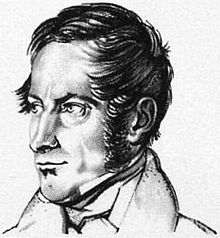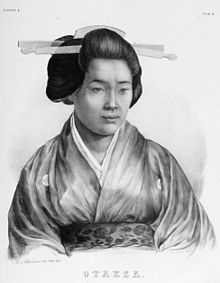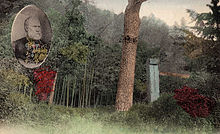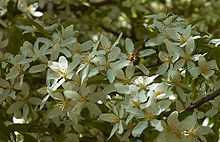- Philipp Franz von Siebold
-
Philipp Franz von Siebold 
Born February 17, 1796
Würzburg, Bishopric of WürzburgDied October 18, 1866 (aged 70)
Munich, BavariaNationality German Philipp Franz Balthasar von Siebold (February 17, 1796 – October 18, 1866) was a German physician and traveller. He was the first European to teach Western medicine in Japan. He obtained significance for his study of Japanese flora and fauna.
Contents
Career
Early life
Born into a family of doctors and professors of medicine in Würzburg (then in the Bishopric of Würzburg), von Siebold initially studied medicine at University of Würzburg from November 1815, where he became a member of the Corps Moenania Würzburg. One of his professors was Franz Xaver Heller (1775–1840), author of the Flora Wirceburgensis ("Flora of the Grand Duchy of Würzburg", 1810–1811). Ignaz Döllinger (1770–1841), his professor of anatomy and physiology, however, most influenced him. Döllinger was one of the first professors to understand and treat medicine as a natural science. Von Siebold stayed with Döllinger, where he came in regular contact with other scientists. He read the books of Alexander von Humboldt, a famous naturalist and explorer, which likely raised his desire to travel to distant lands. Philipp von Siebold became a doctor by earning his M.D. in 1820. He initially practiced medicine in Heidingsfeld, Germany (now part of Würzburg).
Invited to Holland by an acquaintance of the family, von Siebold applied for a position as a military doctor. This position would enable him to travel to the Dutch colonies. He entered Dutch military service on June 19, 1822. He was appointed ship's doctor on the frigate Adriana on the voyage from Rotterdam to Batavia (present-day Jakarta) in the Dutch East Indies (present-day Indonesia). On his trip to Batavia on the frigate Adriana, he practiced his knowledge of the Dutch language and rapidly learned Malay. During the long trip, von Siebold started a collection of marine fauna. He arrived in Batavia on February 18, 1823.
As an army medical officer, von Siebold posted with an artillery unit. He stayed, however, a couple of weeks at the residence of the governor-general to recover from illness. With his erudition, he impressed the governor-general baron Godert van der Capellen and the head of the botanical garden Buitenzorg (Bogor), Caspar Georg Carl Reinwardt. Already, these men sensed a successor to Engelbert Kaempfer and Carl Peter Thunberg (author of Flora Japonica), both former resident physicians at Dejima. The Batavian Academy of Arts and Science made von Siebold a member.
Arrival in Japan
Siebold was sent to Dejima, the artificial island next to Nagasaki, on June 28, 1823, and arrived on August 11, 1823 as the new resident physician and scientist. During his eventful trip he barely escaped drowning during a typhoon in the East China Sea. Since only a very limited number of Dutch citizens were allowed on this island, the posts of physician and scientist had to be combined. At that time, Dejima was no longer in the possession of the Dutch East Indian Company but was kept running by the Dutch State, because of political reasons.
The European tradition of sending doctors with botanical training to Japan was a long one. Sent on a mission by the Dutch East India Company, Engelbert Kaempfer (1651–1716), a German physician and botanist who lived in Japan from 1690 until 1692, ushered in this tradition of a combination of physician and botanist. The Dutch East India Company did not, however, actually employ the Swedish botanist and physician Carl Peter Thunberg (1743–1828), who arrived in Japan in 1775.
Medical practise
Japanese scientists invited Siebold to show them the marvels of western science, and he learned in return through them much about the Japanese and their customs. After curing an influential local officer, Siebold gained the ability to leave the trade post. He used this opportunity to treat Japanese patients in the greater area around the trade post. Siebold is credited with the introduction of vaccination and pathological anatomy for the first time in Japan.[1]
Siebold began a medical school with 50 students appointed by the Shogun (see Rangaku). They helped him in his botanical and naturalistic studies. His school, the Narutaki-juku, grew into a meeting place for around 50 rangakusha. Recognized by the Japanese, von Siebold served as an expert on Western science. The Dutch language became the lingua franca (common spoken language) for these academic and scholarly contacts for a generation, until the Meiji Restoration.
His patients paid him in kind with a variety of objects and artifacts that would later gain historical significance. These everyday objects later became the basis of his large ethnographic collection, which consisted of everyday household goods, woodblock prints, tools and hand-crafted objects used by the Japanese people.
Japanese wife
Since mixed marriages were forbidden, von Siebold "lived together" with his Japanese partner Kusumoto Taki (楠本滝). In 1827 Kusumoto Taki gave birth to their daughter, Oine. Von Siebold used to call his wife "Otakusa" and named a Hydrangea after her. As a result of her father's efforts, Oine eventually became the first Japanese woman known to have received a physician's training, and became a highly-regarded practicing physician. She died in 1903.
Studies of Japanese fauna and flora
His main interest, however, focused on the study of Japanese fauna and flora. He collected as much material as he could. Starting a small botanical garden behind his home (there was not much room on the small island) Siebold amassed over 1,000 native plants. In a specially built glasshouse he cultivated the Japanese plants to endure the Dutch climate. Local Japanese artists drew images of these plants, creating botanical illustrations and images of the daily life in Japan, which complemented his ethnographic collection. He hired Japanese hunters to track rare animals and collect specimens. Many specimens were collected with the help of his Japanese collaborators Keisuke Ito (1803–1901), Mizutani Sugeroku (1779–1833), Ohkochi Zonshin (1796–1882) and Katsuragawa Hoken (1797–1844), a physician to the Shogun. As well, von Siebold's assistant and later successor, Heinrich Bürger (1806–1858), proved to be indispensable in carrying on von Siebold's work in Japan.
Siebold first introduced to Europe such familiar garden-plants as the Hosta and the Hydrangea otaksa. Unknown to the Japanese, he was also able to smuggle out germinative seeds of tea plants to the botanical garden Buitenzorg in Batavia. Through this single act, he started the tea culture in Java, a Dutch colony at the time. Until then Japan had strictly guarded the trade in tea plants. Remarkably, in 1833, Java already could boast a half million tea plants.
During his stay at Dejima, he sent three shipments with an unknown number of herbarium specimens to Leiden, Ghent, Brussels and Antwerp. The shipment to Leiden contained the first specimens of the Japanese giant salamander (Andrias japonicus) to be sent to Europe.
In 1825 the East Indian Company provided him with two assistants: apothecary and mineralogist Heinrich Bürger (his later successor) and the painter Carl Hubert de Villeneuve. Each would prove to be useful to Siebold's efforts that ranged from ethnographical to botanical to horticultural, when attempting to document the exotic Eastern Japanese experience.
Reportedly, Siebold was not the easiest man to deal with; he was in continuous conflict with his Dutch superiors, who felt he was arrogant. This threat of conflict resulted in his recall in July 1827 back to Batavia. But the ship, the Cornelis Houtman, sent to carry Siebold back to Batavia, was thrown ashore by a typhoon in Nagasaki bay. The same storm badly damaged Dejima and destroyed Siebold's botanical garden. Repaired, the Cornelis Houtman set afloat. It left for Batavia with 89 crates of Siebold's salvaged botanical collection, but Siebold, however, remained behind in Dejima.
Siebold Incident
In 1826 Siebold made the court journey to Edo. During this long trip he collected many plants and animals. But he also obtained from the court astronomer Takahashi Kageyasu several detailed maps of Japan and Korea (written by Inō Tadataka), an act strictly forbidden by the Japanese government. When the Japanese discovered, by accident, that von Siebold had mapped northern parts of Japan, the government accused him of high treason and of being a spy for Russia.
The Japanese ordered Siebold into house arrest and expelled him from Japan on October 22, 1829. Satisfied that his Japanese collaborators would continue his work, he journeyed back on the frigate Java to his former residence, Batavia, in possession of his enormous collection of thousands of animals and plants, his books and his maps. The botanical garden of Buitenzorg would soon house von Siebold's surviving, living flora collection of 2,000 plants. He arrived in the Netherlands on July 7, 1830. His stay in Japan and Batavia had lasted for a period of eight years.
Return to Europe
Philipp Franz von Siebold arrived just at a time when, in 1830, political troubles erupted in Brussels, leading soon to the Belgian independence. Hastily he salvaged his ethnographic collections in Antwerp and his herbarium specimens in Brussels and took them to Leiden. He left behind his botanical collections of living plants that were sent to the University of Ghent. The consequent expansion of this collection of rare and exotic plants led to the horticultural fame of Ghent. In gratitude the University of Ghent presented him in 1841 with specimens of every plant from his original collection.
Siebold settled in Leiden, taking with him the major part of his collection. The "Philipp Franz von Siebold collection," containing many species type specimens, was the earliest botanical collection from Japan. Even today, it still remains a subject of ongoing research, a testimony to the depth of work undertaken by Siebold. It contained about 12,000 specimens, from which he could describe only about 2,300 species. The whole collection was purchased for a handsome amount by the Dutch government. Siebold was also granted a substantial annual allowance by the Dutch King William II and was appointed Advisor to the King of Japanese Affairs. In 1842 the King even raised Siebold to the peerage as an esquire.
The "Siebold collection" opened to the public in 1831. He founded a museum in his home in 1837. This small, private museum would eventually evolve into the National Museum of Ethnology in Leiden.[2] Seibold's successor in Japan, Heinrich Bürger, sent Siebold three more shipments of herbarium specimens collected in Japan. This flora collection formed the basis of the Japanese collections of the National Herbarium of the Netherlands[3] in Leiden and the natural history museum Naturalis (National Natuurhistorisch Museum).[4]
Writings
During his stay in Leiden Siebold wrote Nippon in 1832, the first volume of a richly illustrated ethnographical and geographical work on Japan. It also contained a report of his journey to the Shogunate Court at Edo. He wrote six further volumes, the last ones published posthumously in 1882. His sons published an edited and cheap reprint in 1887.
The Bibliotheca Japonica appeared between 1833 and 1841. This work was co-authored by Joseph Hoffmann and Kuo Cheng-Chang, a Javanese of Chinese extraction, who had journeyed along with von Siebold from Batavia. It contained a survey of Japanese literature and a Chinese, Japanese and Korean dictionary.
The zoologists Coenraad Temminck (1777–1858), Hermann Schlegel (1804–1884), and Wilhem de Haan (1801–1855) "scientifically" described and documented Siebold's collection of Japanese animals. The Fauna Japonica, a series of monographs published between 1833 and 1850, was mainly based on Siebold's collection, making the Japanese fauna the best-described non-European fauna - "a remarkable feat for von Siebold". A significant part of the Fauna Japonica was also based on the collections of Siebold's successor on Dejima, Heinrich Bürger.
Siebold wrote his Flora Japonica in collaboration with the German botanist Joseph Gerhard Zuccarini (1797–1848). It first appeared in 1835, but the work was not completed until after his death, finished in 1870 by F. A. W. Miquel (1811–1871), director of the Rijksherbarium in Leiden. This work expanded Siebold's scientific fame from Japan to Europe.
From the Hortus Botanicus Leiden—the botanical garden of Leiden—many of Siebold's plants spread to Europe and from there to other countries. Hosta and Hortensia, Azalea, and the Japanese butterbur and the coltsfoot as well as the Japanese larch began to inhabit gardens across the world.
International reputation
As a well-known expert on Japan, Siebold discovered that his expertise and opinions were sought after by a range of questioners. Whilst living in Boppard, from 1852 he was became involved in correspondence with Russian diplomats such as Baron von Budberg-Bönninghausen, the Russian ambassador to Prussia.
American Naval Commodore Matthew C. Perry consulted Siebold in advance of his voyage to Japan in 1854.[5]
In later years, von Siebold became an adviser on Japanese cultural and social issues for several governments. This position granted Siebold a return to Japan as an "adviser" from 1859 till 1863. While back in Japan, he went to see Kusomoto Sonogi several times. His proposals for a "cultural" approach to the Japanese, instead of a "mercantile" approach were not appreciated by the Dutch government. The Dutch Government recalled Siebold, first to Batavia and then to Holland. Disillusioned by this lack of understanding of Japan and his own failure to be appreciated, von Siebold returned to his native town of Würzburg, offering in vain his services to the French and Russian governments. He died in Munich on October 18, 1866.
Plants named after Siebold
The botanical and horticultural spheres of influence have honored Philipp Franz von Siebold by naming some of the finest and most garden-worthy plants in their genera. Examples are as follows:
- Acer sieboldianum or Siebold's Maple is a variety of maple native to Japan
- Calanthe sieboldii or Siebold's Calanthe is a terrestrial evergreen orchid native to Japan, the Ryukyu Islands and Taiwan.
- Clematis florida var. sieboldiana (syn: Cl. florida 'Sieboldii' & Cl. florida 'Bicolor'): a somewhat difficult Clematis to grow "well" but a much sought after plant nevertheless
- Dryopteris sieboldii: a fern with leathery fronds
- Hosta sieboldii of which a large garden may have a dozen quite distinct cultivars
- Magnolia sieboldii: the under-appreciated small "Oyama" magnolia
- Malus sieboldii: the fragrant Toringo Crab-Apple, whose pink buds fade to white
- Primula sieboldii: the Japanese woodland primula Sakurasou (Chinese/Japanese: 櫻草)
- Prunus sieboldii: a flowering cherry
- Sedum sieboldii: a succulent whose leaves form rose-like whorls
- Tsuga sieboldii: a Japanese hemlock
- Viburnum sieboldii: a deciduous large shrub (H: 4m by S: 6m) that has creamy white flowers in spring and red berried that ripen to black in autumn.
In addition to these examples, which demonstrate the honor gained by von Siebold, there are more plants named as a tribute to him, which are not mentioned above. Also a type of abalone, Nordotis gigantea, is known as Siebold's Abalone,[6] and is prized for sushi.
Though he is well known in Japan ("Shiboruto-san"), mentioned in the relevant schoolbooks, von Siebold is almost unknown to the Dutch, Germans or Americans, except among gardeners who admire many plants with the entitlement of the sieboldii and sieboldiana. The Hortus Botanicus in Leiden has recently laid out the "von Siebold Memorial Garden", a Japanese garden with plants sent by von Siebold. Japanese visitors come and visit this garden, to pay their respect for him.
Siebold museums
Sword given to Siebold by Tokugawa Iemochi on November 11, 1861, on display at the State Museum of Ethnology in Munich
Although he was disillusioned by what he perceived as a lack of appreciation for Japan and his contributions to its understanding, a testimony of the remarkable character of von Siebold is found in museums that honor him.
- The Ethnological Museum at Leiden (The Netherlands) houses the large collection Von Siebold brought together during his first stay in Japan (1823–1829).
- The State Museum of Ethnology in Munich, Germany, houses the collection of Philipp Franz von Siebold from his second voyage to Japan (1859–1862) and a letter of Siebold to King Ludwig I in which he urged the monarch to found a museum of ethnology at Munich. Siebold's grave, in the shape of a Buddhist pagoda, is in the Alter Münchner Südfriedhof (Former Southern Cemetery of Munich). Also the name of a street and a plenty of hints in the Botanical Garden at Munich commemorate von Siebold.
- A museum now stands in a transformed, refitted, formal, first house of von Siebold in Leiden: the Siebold Huis.
- A Siebold-Museum exists in Würzburg, Germany.
- Nagasaki, Japan, pays tribute to von Siebold by housing the Siebold Memorial Museum on property adjacent to von Siebold's former residence in the Narutaki neighborhood. The first museum dedicated to a non-Japanese in Japan.
His collections laid the foundation for the ethnographic museums of Munich and Leiden. Alexander von Siebold, his son to his European wife, donated much of the material left behind after von Siebold's death in Würzburg to the British Museum in London. The Royal Scientific Academy of St. Petersburg purchased 600 colored plates of the Flora Japonica.
His other son Heinrich (Henry) von Siebold (1852–1908), continued part of his father's research. As well, he is recognized together with Edward S. Morse as one of the founders of modern archaeological efforts in Japan.
Published works
- (1832–1852) Nippon. Archiv zur Beschreibung von Japan und dessen Neben- und Schutzländern: Jezo mit den Südlichen Kurilen, Krafto, Koorai und den Liukiu-Inseln. 7 volumes, Leiden.
- (1838) Voyage Au Japon Executé Pendant Les Années 1823 a 1830 - French abridged version of Nippon - contains 72 plates from Nippon, with a slight variance in size and paper.
- Revised and enlarged edition by his sons in 1897: Nippon. Archiv zur Beschreibung von Japan ..., 2. veränderte und ergänzte Auflage, hrsg. von seinen Söhnen, 2 volumes, Würzburg and Leipzig.
- (1829) Synopsis Hydrangeae generis specierum Iaponicarum. In: Nova Acta Physico-Medica Academiae Caesareae Leopoldino-Carolina vol 14, part ii.
- (1835–1870) (with von Zuccarini, J.G.) Flora Japonica. Leiden.
- (1843) (with von Zuccarini, J.G.) Plantaram, quas in Japonia collegit Dr. Ph. Fr. De Siebold genera nova, notis characteristicis delineationibusque illustrata proponunt. In: Abhandelungen der mathematisch-physikalischen Classe der Königlich Bayerischen Akademie der Wissenschaften vol.3, pp 717–750.
- (1845) (with von Zuccarini, J.G.) Florae Japonicae familae naturales adjectis generum et specierum exemplis selectis. Sectio prima. Plantae Dicotyledoneae polypetalae. In: Abhandelungen der mathematischphysikalischen Classe der Königlich Bayerischen Akademie der Wissenschaften vol. 4 part iii, pp 109–204.
- (1846) (with von Zuccarini, J.G.) Florae Japonicae familae naturales adjectis generum et specierum exemplis selectis. Sectio altera. Plantae dicotyledoneae et monocotyledonae. In: Abhandelungen der mathematischphysikalischen Classe der Königlich Bayerischen Akademie der Wissenschaften vol. 4 part iii, pp Band 4 pp 123–240.
- (1841) Manners and customs of the Japanese, in the nineteenth century. From recent Dutch visitors of Japan and the German of Dr. Ph. Fr. von Siebold. London: Murray 1841. (compiled by an anonymous author, not by Siebold himself !)
See also
- Bunsei—Japanese era names
- Dejima
- Karl Theodor Ernst von Siebold
- Erwin Bälz
Notes
- ^ Odagiri, Hiroyuki (1996). Technology and Industrial Development in Japan. Clarendon Press, Oxford. p. 236. ISBN 0-19-828802-6.
- ^ Otterspeer, W. (1989). Leiden Oriental Connections, 1850–1940, p. 289.
- ^ Nationaal Herbarium Nederland
- ^ Naturalis homepage (in English)
- ^ Sewall, John S. (1905). The Logbook of the Captain's Clerk: Adventures in the China Seas, p. xxxviii.
- ^ "“Siebold's abalone (Nordotis gigantea), disk abalone (Nrodotis discus), and red sea cucumber (Holothroidea) in Fukuoka Prefecture”". JST: Science Links Japan. 2009. http://sciencelinks.jp/j-east/article/200403/000020040303A0861607.php. Retrieved February 16, 2011.
- ^ "Author Query". International Plant Names Index. http://www.ipni.org/ipni/authorsearchpage.do.
References
- Eberhard Friese: Philipp Franz von Siebold als früher Exponent der Ostasienwissenschaften. = Berliner Beiträge zur sozial- und wirtschaftswissenschaftlichen Japan-Forschung Bd. 15. Bochum 1983 ISBN 3-88339-315-0
- Otterspeer, W. (1989). Leiden Oriental Connections, 1850–1940, Vol. V: Studies in the History of Leiden University. Leiden: E. J. Brill. ISBN 978-90040-9022-4
- Richtsfeld, Bruno J.: Philipp Franz von Siebolds Japansammlung im Staatlichen Museum für Völkerkunde München. In: Miscellanea der Philipp Franz von Siebold Stiftung 12, 1996, S. 34 - 54.
- Richtsfeld, Bruno J.: Philipp Franz von Siebolds Japansammlung im Staatlichen Museum für Völkerkunde München. In: 200 Jahre Siebold, hrsg. von Josef Kreiner. Tokyo 1996, S. 202 - 204.
- Richtsfeld, Bruno J.: Die Sammlung Siebold im Staatlichen Museum für Völkerkunde, München. In: Das alte Japan. Spuren und Objekte der Siebold-Reisen. Herausgegeben von Peter Noever. München 1997, S. 209f.
- Richtsfeld, Bruno J.: Philipp Franz von Siebold (1796–1866). Japanforscher, Sammler und Museumstheoretiker. In: Aus dem Herzen Japans. Kunst und Kunsthandwerk an drei Flüssen in Gifu. Herausgegeben von dem Museum für Ostasiatische Kunst Köln und dem Staatlichen Museum für Völkerkunde München. Köln, München 2004, S. 97 - 102.
- Sewall, John S. (1905). The Logbook of the Captain's Clerk: Adventures in the China Seas, Bangor, Maine: Chas H. Glass & Co. [reprint by Chicago: R.R. Donnelly & Sons, 1995] ISBN 0-5482-0912-X
- Yamaguchi, T., 1997. Von Siebold and Japanese Botany. Calanus Special number I.
- Yamaguchi, T., 2003. How did Von Siebold accumulate botanical specimens in Japan? Calanus Special number V.
- The Siebold herbarium
- E. M. Binsbergen. "Philipp Franz von Siebold (1796–1866). Wetenschapper in de Oost [Philipp Franz von Siebold (1796–1866). Scientist in the East]" (in Dutch). University of Amsterdam. http://www.uba.uva.nl/collecties/object.cfm/objectid=34853D0C-C771-4E13-8B78334417AB31EE.
External links
- Scanned versions of Flora Japonica and Fauna Japonica
- Fauna Japonica—University of Kyoto
- Flora Japonica—University of Kyoto
- Siebold University of Nagasaki
- Siebold Huis—a museum in the house where Siebold lived in Leiden
- The Siebold Museum in Würzburg
- Siebold's Nippon, 1897 (German)
- Proceedings of the symposium 'Siebold in the 21st Century' held at the University Museum, the University of Tokyo, in 2003
 Texts on Wikisource:
Texts on Wikisource:
- "Siebold, Philipp Franz von". New International Encyclopedia. 1905.
- Chisholm, Hugh, ed (1911). "Siebold, Philipp Franz von". Encyclopædia Britannica (11th ed.). Cambridge University Press.
- "Siebold, Philipp Franz von". Encyclopedia Americana. 1920.
Categories:- Botanists with author abbreviations
- 1796 births
- 1866 deaths
- Botanists active in Japan
- Carcinologists
- German botanists
- German expatriates in Japan
- Japanologists
- People from Würzburg
Wikimedia Foundation. 2010.







